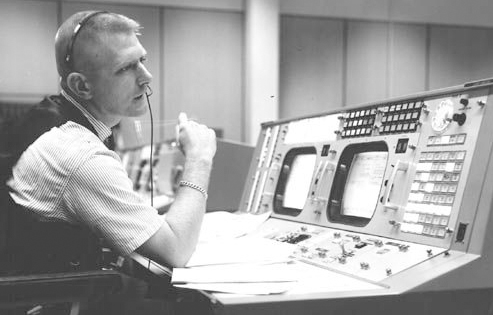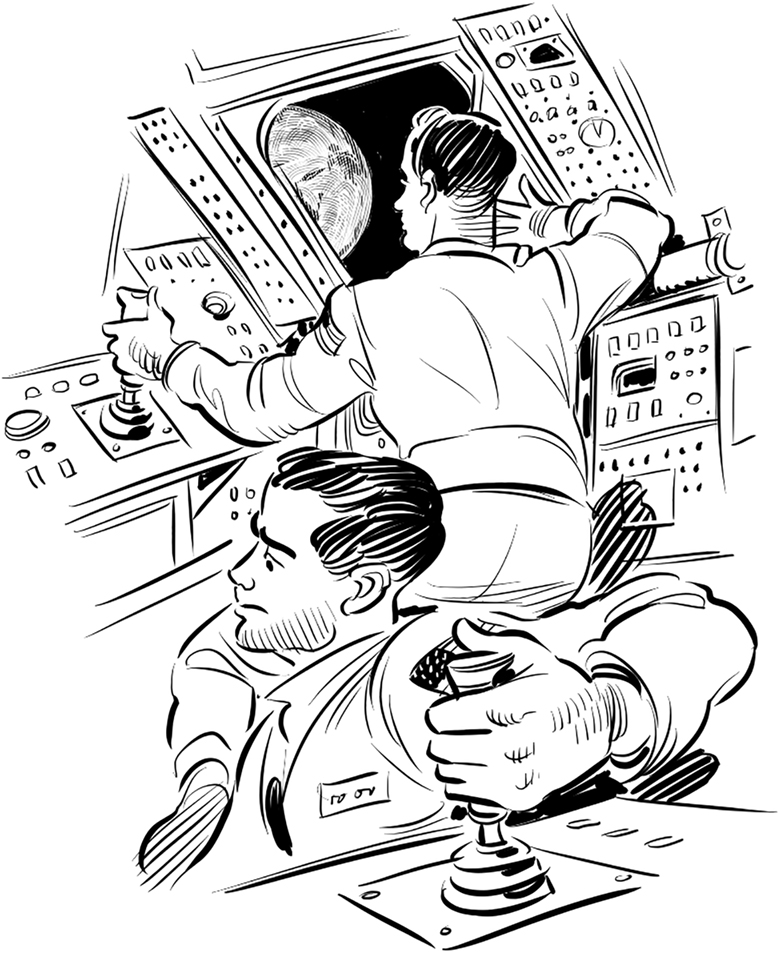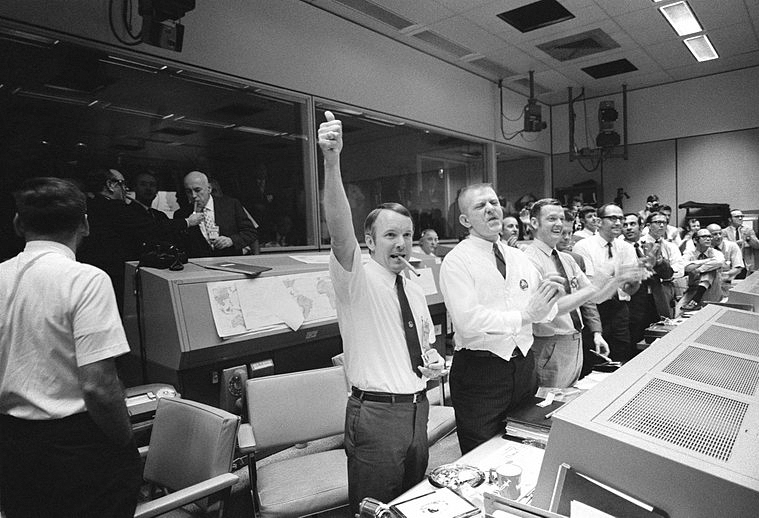1970
“It really was not until I looked out the window and saw the oxygen escaping from the rear end of my spacecraft that I knew that we were in serious trouble.” —Jim Lovell
It was just a few minutes after 9 PM, eastern time, on April 13, 1970, and the crew inside the Apollo 13 CSM were just winding down after broadcasting a tour of their ship live on national television. Astronauts Jack Swigert, Fred Haise, and Jim Lovell had spent the last hour carrying a TV camera around the CSM and LM, showing off in zero gravity, answering questions, and talking about all the cool stuff that was going on during their quest to become the third mission in history to land on the lunar surface. They’d been in space for over two days and were now more than halfway between the Earth and the moon. With the excitement over, the crew settled down to perform a little bit of routine maintenance as they rocketed toward their objective.
From Mission Control in Houston, Jack Lousma radioed in a few “housekeeping” items for the crew to take care of before bed. They were asked to power down a couple of systems, run a diagnostic on a couple more, and then stir the tanks containing the liquid oxygen that Apollo 13 was using for fuel to keep it from freezing.
And that’s when a nice, quiet night in the CSM suddenly became an epic struggle between life and death.
A split second after Jack Swigert flipped the switch to stir the cryo tanks, the entire spacecraft was rocked by a huge explosion. As alarms screamed and the entire control board flashed a crazy variety of colors, astronauts Swigert, Haise, and Lovell all immediately sprang into action, knowing that even the smallest hole in their vessel would mean almost instant death.

They radioed in to Houston, reporting that all the gauges were flipping out—a number of crucial systems were offline, and the ship was starting to rock and jerk around like crazy. The onboard computer had gone to an automatic restart and was booting back up again. Unsure what was happening, Apollo 13’s call to Houston is now one of the most famous quotes in the history of spaceflight:
“Houston, we’ve had a problem.”
In the following few minutes, the astronauts calmly but quickly relayed to Mission Control what they were seeing, while the crew on the ground tried to figure out whether this was a computer malfunction or something worse. Astronaut Jim Lovell’s immediate thought was that the LM had been hit by a meteor, so he ordered the hatch to be shut between the CSM and the LM, but upon looking out the cockpit window, he saw something much more terrifying:
The Apollo 13 spacecraft was venting gas into space.
Jim Lovell was no stranger to spaceflight. He had flown Gemini 7, been on Gemini 12 with Buzz Aldrin, and piloted the CSM during the Apollo 8 mission that orbited the moon for the first time. He was a pro and had iron nerves, but he also knew this was really bad. If the crew of Apollo 13 were going to get out of this alive, they were going to need to work quickly.
At the time, nobody knew what had happened to the SM, but we now know that one of the wires in the fuel cell oxygen tank had short-circuited and sparked, igniting oxygen in the tank and creating a big explosion. Oxygen tank 2 was destroyed, oxygen tank 1 was leaking gas into space, and fuel cells 1 and 3 had failed.
In short, Apollo 13 was 200,000 miles from Earth, and it had just lost most of its light, water, and electrical power. With one flip of a switch, the mission had gone from “become the third group of astronauts to set foot on the moon” to “how are we going to get these guys home alive?”
The CSM was dying, leaking fuel and gas, so the first thing to do was to shut it down and move the crew into the LM, which luckily was undamaged by the explosion. Swigert, Haise, and Lovell powered up the LM as quickly as possible, performing a job that usually takes hours in just 15 minutes, and then, before transferring, they shut down all power in the CSM completely—something that had never been done in space before, and something that was seriously not recommended. Whether they’d be able to power the CSM back up again for reentry would remain to be seen. But that was a problem to deal with later.
Back in Houston, NASA teams scrambled to think of ways to get these men home alive. Flight Directors Gene Kranz, Gerald Griffin, and Glynn Lunney mobilized teams to work around the clock to figure out new scenarios for getting 13 back to Earth on limited power. Flight plans for NASA typically took months to put together and required a ton of supercomplicated mathematics, but Mission Control didn’t have that kind of time. The LM was designed to support two astronauts for two days; now it was going to have to support three men for four days!

Gene Kranz at Mission Control during the Apollo 13 mission
Getting back wouldn’t be as easy as just “turning the ship around” and flying back to Earth. Altering course like that would take a ton of fuel and power, and Apollo 13 didn’t have much of either. So instead of turning around, NASA decided to continue to the moon, take one orbit around it, and then use the gravity from the moon to “slingshot” 13 back to Earth. This would take longer, which was bad because the astronauts had limited food and water, but it would use less power and fuel and give 13 the best chance of getting back.

Unfortunately, this change of plans was going to require two major course corrections, and those corrections were going to have to be done from the LM, not the CSM.
Because nobody knew exactly what the damage was to the CSM, it was too risky to fire up the engine. NASA decided to do the correction by firing the LM engine—even though that was designed only to land on the moon, not to propel the spacecraft through outer space! Plus, not only did they not know if this would work, but the LM was at the back end of the craft, and all the navigation equipment was in the CSM. Still, using a computer for visuals, which had never been done in space before, Fred and Jim worked together to get the craft moving into a path that would take it around the moon. Jim later said that it was “like learning how to fly all over again.” No pressure, right?
Miraculously, Jim Lovell and Fred Haise got 13 onto course. Once everything looked good, the crew then had to shut down power to the LM as well. They were going to need that battery power later. For the next couple of days, the entire Apollo 13 spaceship was running on 12 amps of power. Most regular hair dryers run on 15!
There was plenty of oxygen on board the ship, but the LM was designed for only two people. Three people were producing too much carbon dioxide in the cabin. Carbon dioxide (CO2) is the stuff that we exhale, and in large quantities it can be deadly. To “scrub” out the CO2, the crew were going to need the bigger CO2 scrubbers in the CSM, but there was a problem: The CSM scrubbers were square, and the LM scrubbers were round. To plug a CSM scrubber into an LM socket, they were literally going to need to put a square peg into a round hole.


Luckily, they had an entire team of NASA engineers to help them do just that.
Back in Houston, a team of NASA geniuses figured out a crazy way to jury-rig a bizarre-looking device they called the “mailbox,” which would convert the square scrubber to the circular hole. Using cardboard, plastic bags, hoses, and, of course, duct tape (because duct tape fixes everything), the engineers put something together, radioed the astronauts how to build it, and then the crew of Apollo 13 had to do it in zero gravity. And you know what? They did.
Water was also a problem, since a lot of it had been blasted into space during the explosion. The astronauts were having to live on six ounces of water a day—less than one cup. Having the power off made the LM totally freezing; temperatures dropped as low as 38 degrees! Condensation from the cold and the astronauts’ breath covered everything, including the equipment panels. Cold, hungry, thirsty, and exhausted, the astronauts were so miserable they couldn’t even sleep when they were tired because the ship was so uncomfortable. Jim Lovell lost 14 pounds. Fred Haise got a kidney infection and started running a fever.
After leaving lunar orbit and approaching Earth, 13 then needed to power up the LM again to make a second course correction. The window to land safely on Earth was very small, and it’s hard enough to hit it at the best of times, but flying the ship from the LM, without any computer assistance or electronic guidance, was going to take superhuman piloting skill. Failure would mean certain death for the crew.
Lovell and Haise grabbed the LM controls as they received radio transmissions from NASA. Lovell controlled the pitch and the acceleration, but Haise controlled the yaw (the craft’s side-to-side movement), which is completely wild to think about. Imagine trying to play a shooting or flying game on Xbox, except you only control the left stick and your buddy controls the right stick on the same controller. It is not easy!
Because 13 couldn’t afford to restart the computer to calculate reentry, the crew were going to have to navigate the same way old sailing ships did: by looking at the stars. As long as they kept the top-left corner of the Earth in the front window, and the sun in the window directly above them, they would be on the right track. It wasn’t a precise form of navigation, but it was the best they had.


Jim Lovell lined up the Earth and ignited the thrusters on the LM. A huge jet of flame exploded out the back of the thrusters, catapulting the Apollo 13 spacecraft toward home.
Ten seconds later, Houston reported that 13 had hit the target within two degrees. The crew couldn’t have done it better if they’d had the guidance computer in front of them.
After six long days in space, Apollo 13 was now beginning its approach toward Earth’s atmosphere. But success still wasn’t guaranteed.
LMs don’t have heat shields, and because the heat from reentry would burn them to pieces, the crew were going to have to move back to the CSM, boot it up, and hope for the best. Crews on the ground, assisted by guys like astronaut Ken Mattingly, had run hundreds of simulations trying to figure out how to get the CSM up and running on minimal power. By the time Apollo 13 reached the atmosphere, they had a pretty good idea of how to do that. But there were still a lot of questions.
First, remember the condensation making the equipment panels wet? Water and electronics do not go together. Even one malfunction could short out the entire CSM and leave it dead in space. Second, nobody knew how badly the explosion had damaged the CSM. Even one small crack in the heat shield would be deadly during reentry. Third, there was the issue of the parachutes. Were they damaged? Would they deploy and open correctly? Were they frozen into ice cubes? Nobody knew.
Across the world, humanity came together to wish the best for the astronauts. The pope led prayers at the Vatican. People gathered around televisions and radios in their homes, churches, and other meeting areas from Los Angeles to London, hoping that this amazing saga would have a happy ending.
Seven days after lifting off from Cape Canaveral, Jim Lovell, Jack Swigert, and Fred Haise ejected the LM from the damaged CSM, powered up the CM, and began their descent toward Earth. They hurtled toward the surface at hundreds of miles per hour, attempting a daring landing with only a minimal amount of electrical power. All around them, ice and water melted, dripping down onto the astronauts so rapidly it must have felt like rain.
There’s a three-minute radio blackout whenever a spacecraft attempts reentry. News cameras and crewmen aboard the rescue ship USS Iwo Jima scanned the skies, straining to catch any sign of the CM. Families held their breath as they stared at their televisions. What would happen to these brave astronauts?
Then, through the clouds, three bright red parachutes appeared, gently bringing Apollo 13 out of the sky.
A huge cheer erupted on the deck of the Iwo Jima and across the world.
They’d made it.
Apollo 13 splashed down safely in the Pacific Ocean just four miles from its target. Rescue helicopters from the Iwo Jima brought Jim Lovell, Jack Swigert, and Fred Haise back home, where they were celebrated for their bravery, perseverance, and heroism in the face of almost certain death.
The Apollo 13 mission is considered by NASA to be a “successful failure,” meaning that the crew had failed to land on the moon. But NASA had learned so much during the operation, including techniques that would go on to aid in the development of new mission protocols and better technological advancements for future missions. In the end, despite this mission being a pretty Epic Fail, Apollo 13 and its crew have since gone down as one of the greatest survival stories in the history of our species.

Mission Control celebrates the safe return of Apollo 13.